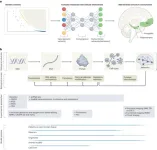(Press-News.org) Technology with roots going back to the Bronze Age may offer a fast and inexpensive solution to help achieve the United Nations climate goal of net zero emissions by 2050, according to recent Stanford-led research in PNAS Nexus.
The technology involves assembling heat-absorbing bricks in an insulated container, where they can store heat generated by solar or wind power for later use at the temperatures required for industrial processes. The heat can then be released when needed by passing air through channels in the stacks of “firebricks,” thus allowing cement, steel, glass, and paper factories to run on renewable energy even when wind and sunshine are unavailable.
These systems, which several companies have recently begun to commercialize for industrial heat storage, are a form of thermal energy storage. The bricks are made from the same materials as the insulating bricks that lined primitive kilns and iron-making furnaces thousands of years ago. To optimize for heat storage instead of insulation, the materials are combined in different amounts.
Batteries can store electricity from renewable sources and provide electricity to generate heat on demand. “The difference between firebrick storage and battery storage is that the firebricks store heat rather than electricity and are one-tenth the cost of batteries,” said lead study author Mark Z. Jacobson, a professor of civil and environmental engineering in the Stanford Doerr School of Sustainability and School of Engineering. “The materials are much simpler too. They are basically just the components of dirt.”
High heat storage
Many industries require high-temperature heat for manufacturing. Temperatures in factories need to reach at least 1,300 degrees Celsius (nearly 2,400 degrees Fahrenheit) to produce cement, and 1,000 C (about 1,800 F) or hotter for glass, iron, and steelmaking. Today, about 17% of all carbon dioxide emissions worldwide stem from burning fossil fuels to produce heat for industrial processes, according to Jacobson and co-author Daniel Sambor’s calculations. Generating industrial heat from renewable sources could all but eliminate these emissions.
“By storing energy in the form closest to its end use, you reduce inefficiencies in energy conversion,” said Sambor, a postdoctoral scholar in civil and environmental engineering. “It’s often said in our field that ‘if you want hot showers, store hot water, and if you want cold drinks, store ice’; so this study can be summarized as ‘if you need heat for industry, store it in firebricks.’”
Substantial savings
The researchers set out to examine the impact of using firebricks to store most industrial process heat in 149 countries in a hypothetical future where each country has transitioned to wind, geothermal, hydropower, and solar for all energy purposes. The 149 countries are responsible for 99.75% of global carbon dioxide emissions from fossil fuels. “Ours is the first study to examine a large-scale transition of renewable energy with firebricks as part of the solution,” Jacobson said. “We found that firebricks enable a faster and lower-cost transition to renewables, and that helps everyone in terms of health, climate, jobs, and energy security.”
The team used computer models to compare costs, land needs, health impacts, and emissions involved in two scenarios for a hypothetical future where 149 countries in 2050 are using renewables for all energy purposes. In one scenario, firebricks provide 90% of industrial process heat. In the other, there’s zero adoption of firebricks or other forms of thermal energy storage for industrial processes. In the no-firebrick scenario, the researchers assumed heat for industrial processes would come instead from electric furnaces, heaters, boilers, and heat pumps, with batteries used to store electricity for those technologies.
The researchers found the scenario with firebricks could cut capital costs by $1.27 trillion across the 149 countries compared with the scenario with no firebrick storage, while reducing demand for energy from the grid and the need for energy storage capacity from batteries.
Clean energy, cleaner air
Solutions for accelerating the transition to clean energy are also connected to human health. Previous research has shown that air pollution from burning fossil fuels causes millions of early deaths each year. “Every bit of combustion fuels we replace with electricity reduces that air pollution,” Jacobson said. “And because there is a limited amount of money to transition at a high speed, the lower the cost to the overall system, the faster we can implement it.”
Jacobson has spent his career understanding air pollution and climate problems and developing energy plans for countries, states, and cities to solve these problems. But his focus on firebricks is relatively new, inspired by a desire to identify effective solutions that could be adopted quickly.
“Imagine if we propose an expensive and difficult method of transitioning to renewable electricity – we’d have very few takers. But, if this will save money compared with a previous method, it will be implemented more rapidly,” he said. “What excites me is that the impact is very large, whereas a lot of technologies that I’ve looked at, they have marginal impacts. Here I can see a substantial benefit at low cost from multiple angles, from helping to reduce air pollution mortality to making it easier to transition the world to clean renewables.”
Jacobson is also a senior fellow at the Stanford Woods Institute for the Environment and the Precourt Institute for Energy.
END
A Bronze Age technology could aid the switch to clean energy
2024-08-02
ELSE PRESS RELEASES FROM THIS DATE:
What researchers know about the genetic complexity of schizophrenia, to date
2024-08-02
Patrick Sullivan, MD, FRANZCP, the Yeargan Distinguished Professor of Psychiatry and Genetics at the UNC School of Medicine, and researchers at the Karolinska Institutet in Stockholm, Sweden, have developed a comprehensive outline of the genetics of schizophrenia. The review was published in Nature Reviews Neuroscience.
Schizophrenia is a neuropsychiatric disorder featuring recurrent episodes of psychosis – such as hallucinations, delusions, and disorganized thinking – with many patients developing apathy, social withdrawal, ...
New study highlights scale and impact of long COVID
2024-08-02
In a new review paper, researchers from the Universities of Arizona, Oxford and Leeds analyzed dozens of previous studies into long COVID to examine the number and range of people affected, the underlying mechanisms of disease, the many symptoms that patients develop, and current and future treatments.
Long COVID, also known as Post-COVID-19 condition, is generally defined as symptoms persisting for three months or more after acute COVID-19. The condition can affect and damage many organ systems, leading to severe ...
How the rising earth in Antarctica will impact future sea level rise
2024-08-02
COLUMBUS, Ohio – The rising earth beneath the Antarctic Ice Sheet will likely become a major factor in future sea level rise, a new study suggests.
Despite feeling like a stationary mass, most solid ground is undergoing a process of deformation, sinking and rising in response to many environmental factors. In Antarctica, melting glacial ice means less weight on the bedrock below, allowing it to rise. How the rising earth interacts with the overlying ice sheet to affect sea level rise is not well-studied, said Terry Wilson, co-author of the study and a senior research scientist at the Byrd Polar and Climate Research Center ...
Research spotlight: Uncovering the links between sleep struggles, substance abuse and suicidal thoughts in teens with depression
2024-08-02
Rebecca Robbins, PhD, of the Division of Sleep and Circadian Disorders at Brigham and Women’s Hospital, is the senior author of a paper published in Psychiatry Research, “Exploring sleep difficulties, alcohol, illicit drugs, and suicidal ideation among adolescents with a history of depression.”
How would you summarize your study for a lay audience?
Suicide is one of the leading causes of death for adolescents in the U.S. We know, due to previous research, that difficulty falling asleep or waking up too early as well as abuse of prescription ...
Boosting children’s voices could help to relieve significant backlogs in the family court, study says
2024-08-02
Giving children a right to be heard and taken seriously when parents separate could help couples reach sustainable child arrangements and relieve significant backlogs in the family court, avoiding unnecessary financial and emotional costs, a new study says.
Mediation, court and legal processes should provide a forum for young people’s views on post-separation arrangements being considered for them to be aired independently and factored in wherever appropriate. Giving them more agency about decisions which affect their lives and futures will help families make more effective ...
Study yields new insights into the link between global warming and rising sea levels
2024-08-02
A McGill-led study suggests that Earth's natural forces could substantially reduce Antarctica’s impact on rising sea levels, but only if carbon emissions are swiftly reduced in the coming decades. By the same token, if emissions continue on the current trajectory, Antarctic ice loss could lead to more future sea level rise than previously thought.
The finding is significant because the Antarctic Ice Sheet is the largest ice mass on Earth, and the biggest uncertainty in predicting future sea levels is how this ice will respond to climate change.
“With nearly 700 million people living in coastal areas and the potential ...
Controlling thickness in fruit fly hearts reveals new pathway for heart disease
2024-08-02
Scientists at Sanford Burnham Prebys and Salk Institute for Biological Studies have uncovered a new role for a protein known for its role in the brain helping control feelings of hunger or satiety, as well as in the liver to aid the body in maintaining a balance of energy during fasting. The new study shows that this protein also supports the maintenance of heart structure and function, but when it is overactive it causes thickening of the heart muscle, which is associated with heart disease.
Excessive thickening of the heart muscle—known as cardiac hypertrophy—is often ...
Improving cat food flavors with the help of feline taste-testers
2024-08-02
Cats are notoriously picky eaters. But what if we could design their foods around flavors that they’re scientifically proven to enjoy? Researchers publishing in ACS’ Journal of Agricultural and Food Chemistry used a panel of feline taste-testers to identify favored flavor compounds in a series of chicken-liver-based sprays. The cats particularly enjoyed the sprays that contained more free amino acids, which gave their kibble more savory and fatty flavors.
Cats have a more acute sense of smell than humans, and the aroma of their food plays a big role in whether they’ll eat or snub what their owner serves for dinner. Feline palates are also more sensitive to umami ...
Subclinical hypothyroidism in early pregnancy associated with more than quadrupled risk of reduced thyroid function within 5 years of delivery
2024-08-02
A new study has shown that subclinical hypothyroidism diagnosed before 21 weeks of pregnancy is associated with more than fourfold higher rates of overt hypothyroidism or thyroid replacement therapy within 5 years of delivery. The study is published in the peer-reviewed journal Thyroid®, the official journal of the American Thyroid Association® (ATA®).
Subclinical hypothyroidism, or a change in the levels of thyroid-stimulating hormone (TSH) that isn’t severe enough to cause symptoms, ...
BNP-Track algorithm offers a clearer picture of biomolecules in motion
2024-08-02
It’s about to get easier to catch and analyze a high-quality image of fast-moving molecules. Assistant Professor Ioannis Sgouralis, Department of Mathematics, and colleagues have developed an algorithm that adds a new level to microscopy: super-resolution in motion.
The cutting-edge advancement of super-resolution microscopy was recognized with the 2014 Nobel Prize in Chemistry for its groundbreaking innovation. It improves optical microscopy with a suite of techniques that overcome the inherent limitations set by the physics of light. The high-frequency oscillations of light waves escape detection ...



